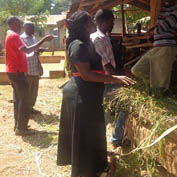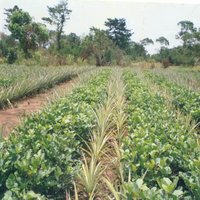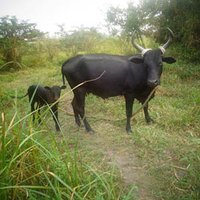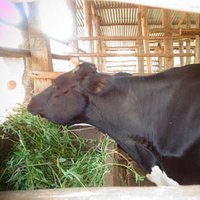Organic conversion is still a challenge to East African farmers
Lack of organic feeds and livestock diseases are the main obstacles to conversion to organic livestock production in East Africa, two ProGroV studies show.

In both Kenya and Uganda lack of organic feeds and livestock diseases are the main challenges for livestock production, according to two exploratory studies conducted by PhD students under the ICRFOS-coordinated project ProGroV (Productivity and Growth of Organic Value Chain). Together these two challenges form a significant barrier to conversion to organic livestock production as well as to a full integration of the crop and livestock production on the East African farms.
However, other studies in East Africa indicate that organic conversion can benefit the smallholders and increase both farmers income and food production. Therefore, the aim of the ProGroV project is to generate research based knowledge to support increased productivity and sustainable growth of organic production, as well as strengthening the value chains and building capacity for future development of the organic sector in Kenya, Uganda and Tanzania.
In order to provide knowledge that can help farmers overcome the challenges, we set out to do exploratory studies among the smallholder organic farms to get an understanding of the current farming practices, identify obstacles and the opportunities that exist.
Organic farming popular in Uganda
The organic subsector of Uganda is one of the most developed in Africa with Uganda having about 400,000 certified organic farmers with approximately 350,000 hectares of land under organic farming. Organic agriculture development in Uganda, like the rest of Africa, has focused mainly on organic crop production. Currently certified organic livestock production is non- existent but there are future prospects for it.
Typically many smallholder farming systems have livestock as part of the farming system due to its contribution to nutrient recycling. With the increasing market for organic food and drinks, organic farmers cannot overlook the opportunity of organic livestock production to target local, regional and international organic markets.
Uganda has witnessed an increasing attraction for certified organic pineapple production due to the prevailing export and local markets which also come with a premium price. So, the organic pineapple value chain is quite important in Uganda. Research in Uganda therefore focused on organic pineapple production systems.
 Farming practices on mixed smallholder organic pineapple farms
Farming practices on mixed smallholder organic pineapple farms
Findings indicated that in both Uganda and Kenya, organic farmers practice mixed crop-livestock production with a diversity of vegetation, trees and animal species.
Land is divided into small plots where various cash and food crops are cultivated. Livestock species kept include cows, goats, pigs and chickens.
The on-farm diversity gives opportunity for different components on the organic farms to interact to enhance intercropping for soil building and nitrogen fixation plus nutrient recycling where crop residues are used for animal feed while manure is ploughed back into the soil for crop production.
The livestock breeds kept are mainly indigenous; however, cross breeds mainly of cattle are kept for purposes of improved milk production. Indigenous breeds are opted for because they are well-adapted to prevailing hot climatic conditions and resistant to endemic diseases. Natural breeding is the form of breeding method for animals used by farmers. As it is, organic animal husbandry also puts emphasis on use of well-adapted breeds as the basic means of disease prevention.
Animal management system
There are three major animal management systems; the commonest being tethering which involves tying the animal with a rope either around the horns or leg. Animal is then allowed to graze around a particular radius; second; zero-grazing where the animal is confined with restricted movement under a cow shed where feed and water are provided to the animal. Lastly, the extensive system, animals are herded or left to roam in search of feeds and water but returned home in the evening. Tethering and extensive management allow free outdoor access and animal movement, an attribute emphasized under organic animal husbandry. But, outdoor grazing also increases the risk of animals getting into contact with parasites and diseases. Zero-grazing might be a better management strategy for preventing disease; however it does not guarantee free movement and natural grazing behavior of animals which is contrary to the organic husbandry requirement. However, where land is a limitation, farmers may adapt it but need to provide an exercise yard for the animals.
 |  |
Local dairy breed tethered | Zero-grazed Friesian cross-breed, stall fed |
Animal feed resources
Majority of organic smallholder farmers use crop residues and natural pastures as the main feed resources for their livestock. Crop residues include banana peels, sweet potatoes vines, pineapple peels and maize stover. Feed conservation in form of silage or hay is not common practice for most farmers which lead to challenges of feeds during dry season. Natural pastures might be a good source of organic feed, however, since they are rain fed and seasonal, there is scarcity during dry seasons. Crop residues and tree forages like Calliandra and Gliricidia are used by some farmers as coping strategies.
Diseases management
The most common animal health concern are endemic pests and diseases mainly helminths, ticks and tick borne diseases. The outdoor grazing of animals increases the disease risks since animals are exposed to pests while grazing on pasture. Local breeds carry better resistance to these diseases. As such, management and breed selection may be strategies that can be adopted by farmers to reduce disease since use of synthetic chemicals is limited in organic farms according to organic standards.
Future perspectives
Future challenges of organic animal husbandry in Uganda lie in the increasing human population with increasing pressure on land for production. Inevitably there might be need for changes from current management systems to more intensified production systems. There is a need to rethink how organic livestock production can be realized. Farmers in Uganda have some husbandry practices compatible with organic farming. However, the limitations to full conversion are still enormous. Ruminant production is based on natural pastures which are limited in quality, thus a need for supplementation with protein rich sources like cereal grains. Needless to mention, these are competed for with human. On the other hand, endemic diseases and pests are a major problem and still largely controlled by synthetic chemical drugs. Strategies are therefore needed to address organic animal nutrition and disease control. This can be achieved through innovative research, in addition to enhancing farmers’ knowledge through trainings and demonstrations.
Further reading:
Nalubwama S, Vaarst M, Kabi F, Kiggundu M, Bagamba F, Odhong C, Mugisha A and Halberg N 2014: Challenges and prospects of integrating livestock into smallholder organic pineapple production in Uganda. Livestock Research for Rural Development. Volume 26, Article #113. Retrieved March 28, 2015, from http://www.lrrd.org/lrrd26/6/nalu26113.htm
Kiggundu. M, Kabi.F, Vaarst. M, Nalubwama.S, and Odhongo. C. 2014. Management and use of dairy cattle feed resources on smallholder certified organic pineapple farms in Central Uganda. Journal of Agriculture and Environment for International Development-JAEID, 108 (2): 207-225
Odhongo, C, Wahome, R.G, Vaarst. M, Kiggundu. M. Nalubwama.S, Halberg.N and Githigia.S. 2014. Challenges of conversion to organic dairy production and prospects of future development in integrated smallholder farms in Kenya. Livestock Research for Rural Development